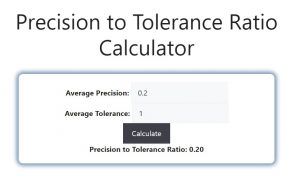About Precision to Tolerance Ratio Calculator (Formula)
The Precision to Tolerance Ratio Calculator is an essential tool for engineers, manufacturers, and quality control professionals. It allows users to assess the precision of a manufacturing process in relation to the acceptable tolerance levels set for a particular product or component. This ratio helps ensure that the produced items meet the required specifications and standards, ultimately leading to higher quality products and customer satisfaction. Understanding and calculating this ratio is crucial in various industries, including automotive, aerospace, and electronics, where precision is paramount.
Formula
The formula to calculate the Precision to Tolerance Ratio is:
Precision to Tolerance Ratio = Precision / Tolerance
Where:
- Precision refers to the degree of reproducibility of measurements or the degree of exactness in a manufacturing process.
- Tolerance is the permissible limit of variation in a physical property of a manufactured item, often expressed as a range (upper and lower limits).
How to Use
To use the Precision to Tolerance Ratio Calculator, follow these steps:
- Determine Precision: Measure or obtain the precision value of the item or process you are evaluating. This may involve statistical analysis or historical data of the measurements taken.
- Establish Tolerance: Identify the tolerance level set for the product. This information is usually defined in the engineering drawings or specifications.
- Input Values: Enter the Precision and Tolerance values into the calculator.
- Calculate Ratio: Click the calculate button to obtain the Precision to Tolerance Ratio.
Example
Let’s consider an example to illustrate how to use the Precision to Tolerance Ratio Calculator:
- Precision: 0.02 mm
- Tolerance: 0.1 mm
Using the formula:
Precision to Tolerance Ratio = Precision / Tolerance
Precision to Tolerance Ratio = 0.02 / 0.1
Precision to Tolerance Ratio = 0.2
In this example, the Precision to Tolerance Ratio is 0.2, indicating that the precision is 20% of the tolerance, which suggests that the manufacturing process is operating well within the specified limits.

FAQs
- What is precision in manufacturing?
Precision refers to the degree to which repeated measurements or processes yield the same result, indicating consistency in manufacturing. - Why is the tolerance important?
Tolerance specifies the allowable limits of variation in a product, ensuring it functions correctly and meets safety standards. - How does precision relate to quality control?
Higher precision typically leads to better quality control, as it ensures products meet strict specifications and reduces the likelihood of defects. - Can this calculator be used for all manufacturing processes?
Yes, the Precision to Tolerance Ratio Calculator can be applied to various manufacturing processes across different industries. - What happens if the precision is greater than the tolerance?
If precision exceeds tolerance, it may indicate an overly stringent manufacturing process, which could increase costs unnecessarily. - Is a higher ratio always better?
Not necessarily. A balance between precision and tolerance is crucial; excessively high precision may not be cost-effective. - How can I improve precision in my processes?
Improving precision can involve better equipment calibration, enhanced training for operators, and adopting advanced manufacturing technologies. - What tools can help measure precision?
Tools such as calipers, micrometers, and statistical process control (SPC) software can help measure and analyze precision. - How do tolerances affect production costs?
Stricter tolerances often lead to higher production costs due to increased inspection and rework requirements. - What industries benefit most from using this calculator?
Industries such as aerospace, automotive, electronics, and medical devices, where precision and quality are critical, benefit significantly from this calculator. - How often should I measure precision?
Precision should be measured regularly, especially after significant changes in the manufacturing process or equipment. - Can I use historical data for precision values?
Yes, historical data can provide a baseline for precision, but it should be regularly updated to reflect current processes. - What is the difference between precision and accuracy?
Precision refers to consistency in measurements, while accuracy refers to how close a measurement is to the true value. - What is an acceptable Precision to Tolerance Ratio?
An acceptable ratio depends on the specific industry and product; generally, a lower ratio indicates a more controlled process. - How can I communicate precision and tolerance in my reports?
Use clear and concise language, supported by visuals such as graphs or charts to illustrate the relationship between precision and tolerance. - Is there a standard for tolerances in manufacturing?
Yes, many industries have established standards for tolerances, such as ISO 2768, which outlines general tolerances for linear dimensions. - What should I do if my ratio is too low?
Investigate the root causes of low precision and take corrective actions, such as improving processes or equipment maintenance. - How does technology influence precision in manufacturing?
Advanced technologies like automation, CNC machining, and 3D printing can enhance precision significantly. - Can this calculator be integrated into software systems?
Many modern manufacturing software systems allow for integration of calculators like this for streamlined data analysis. - What training is necessary for staff to understand precision and tolerance?
Training should include basic concepts of measurement, statistical analysis, and quality control methods related to precision and tolerance.
Conclusion
The Precision to Tolerance Ratio Calculator is a valuable tool for assessing the relationship between precision and tolerance in manufacturing processes. By understanding and optimizing this ratio, manufacturers can enhance product quality, improve customer satisfaction, and reduce costs. The calculator simplifies the calculation process, making it accessible for professionals across various industries. Ultimately, maintaining an appropriate balance between precision and tolerance is key to successful manufacturing operations.